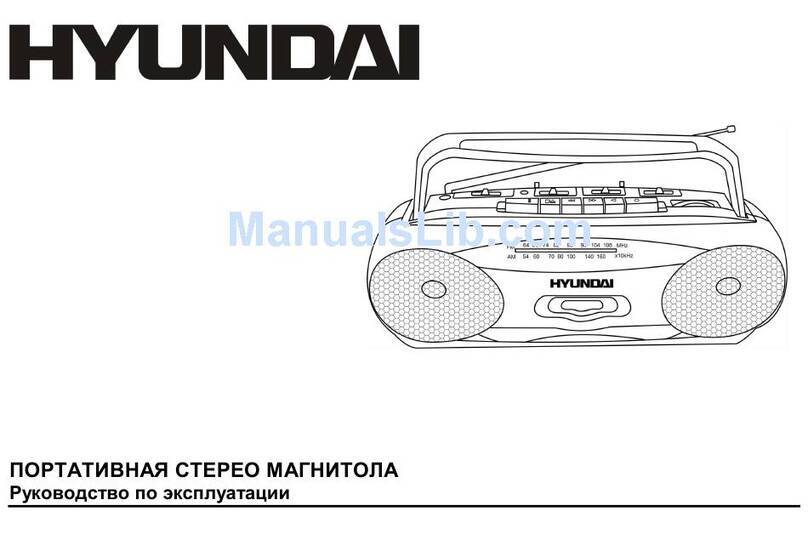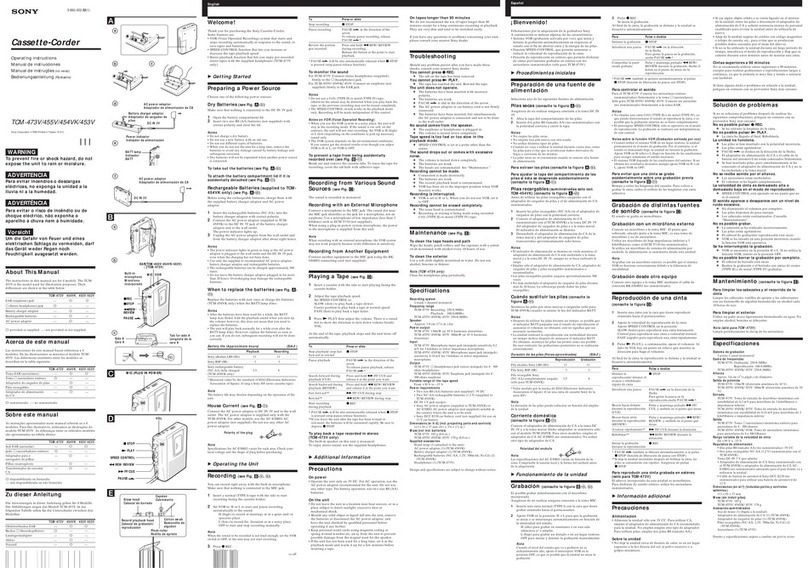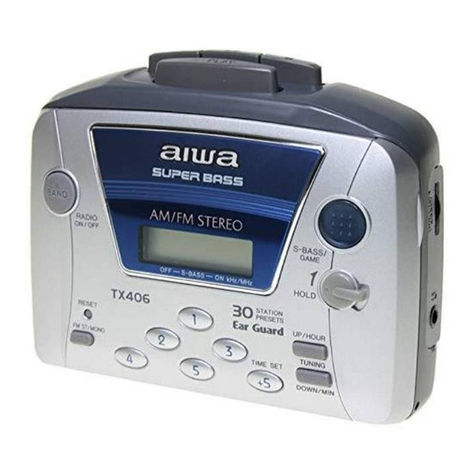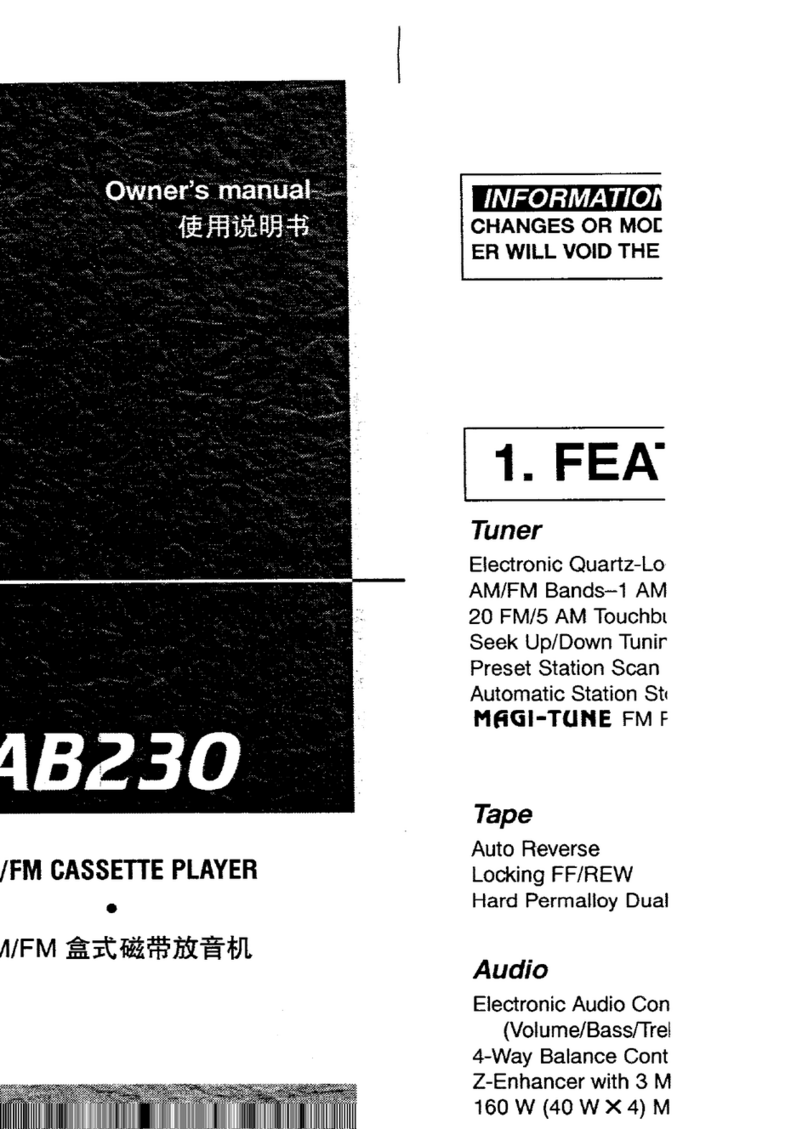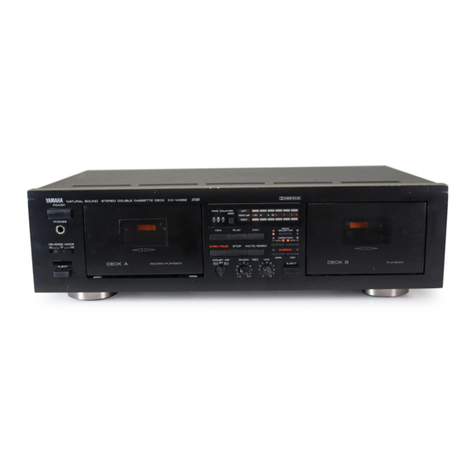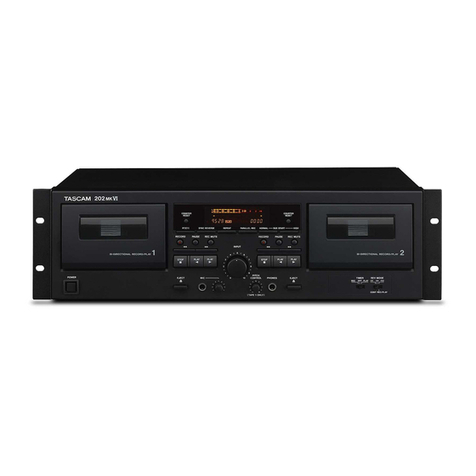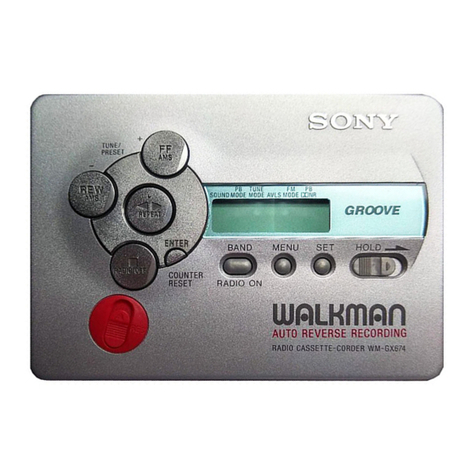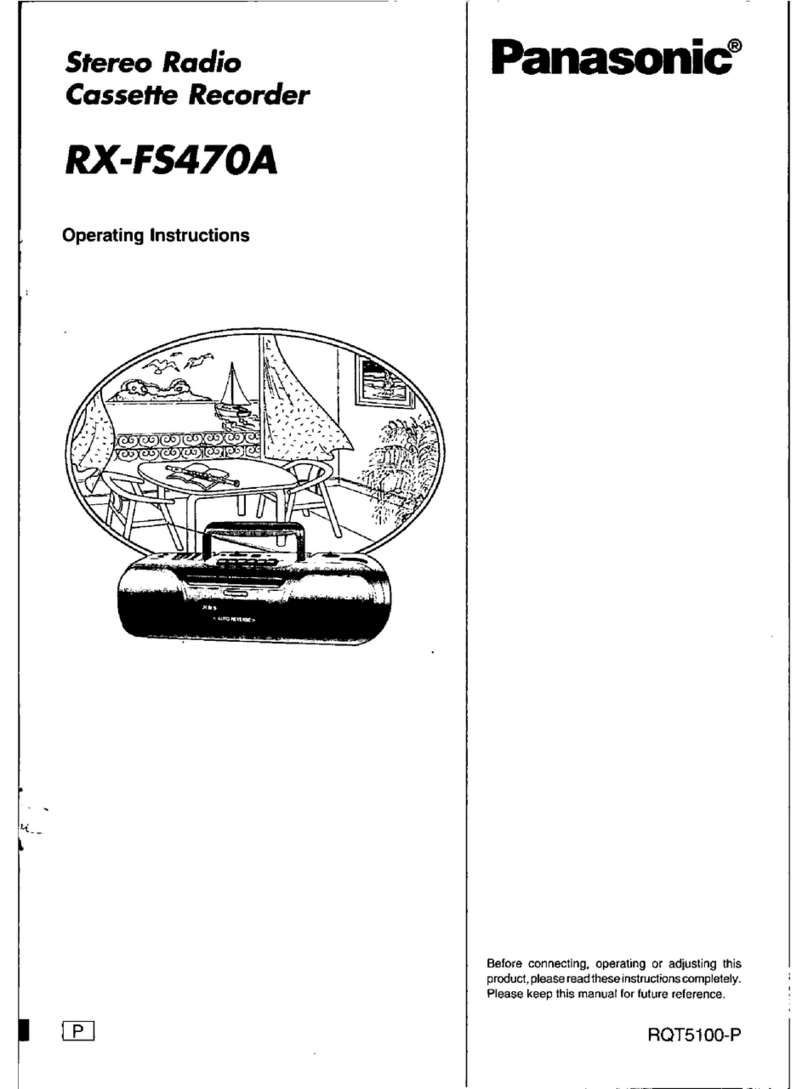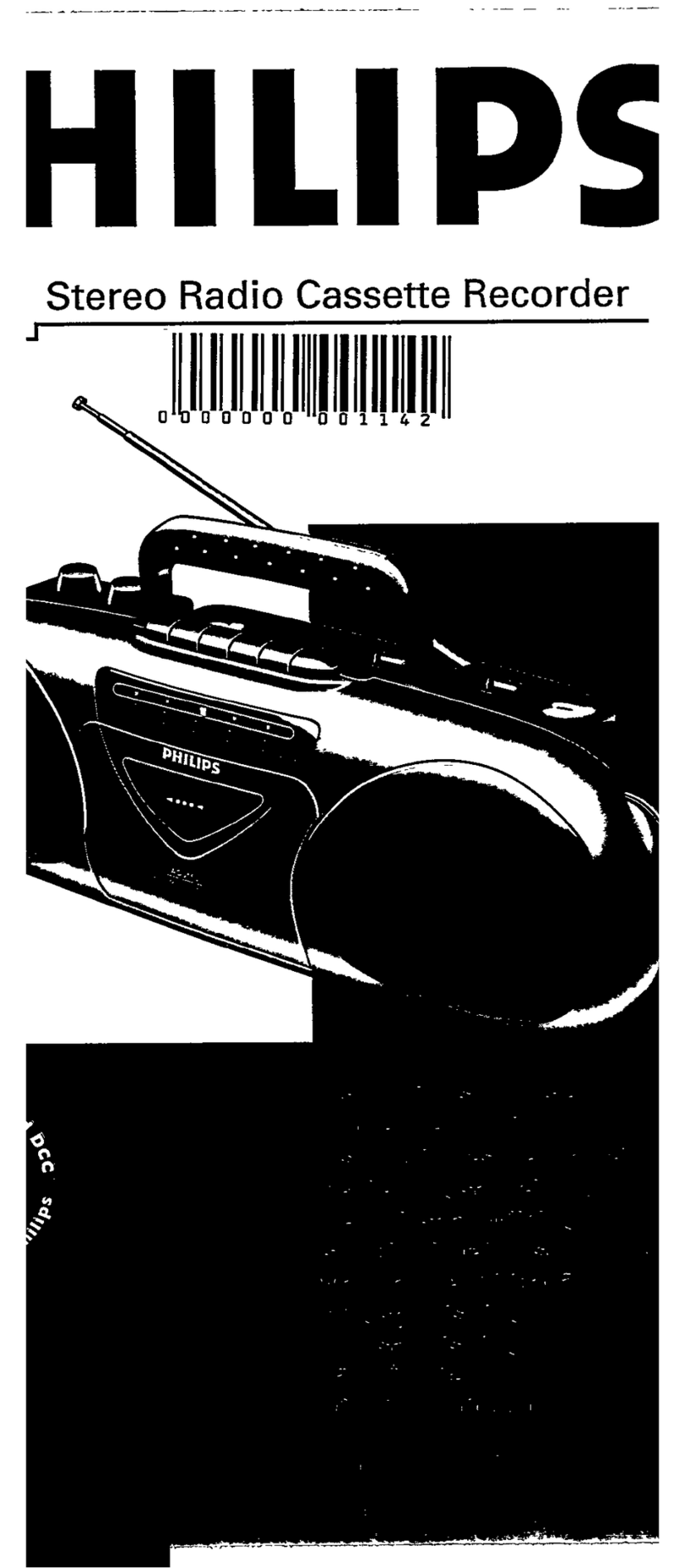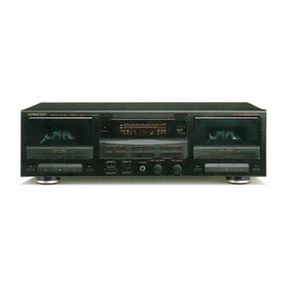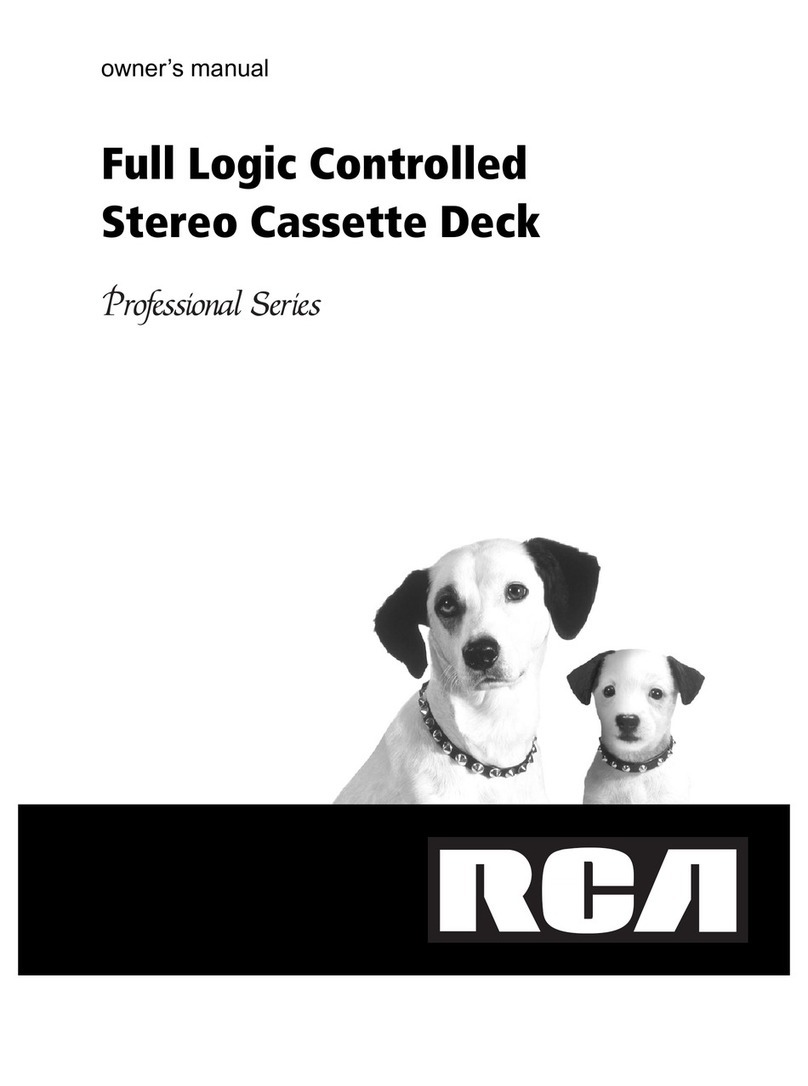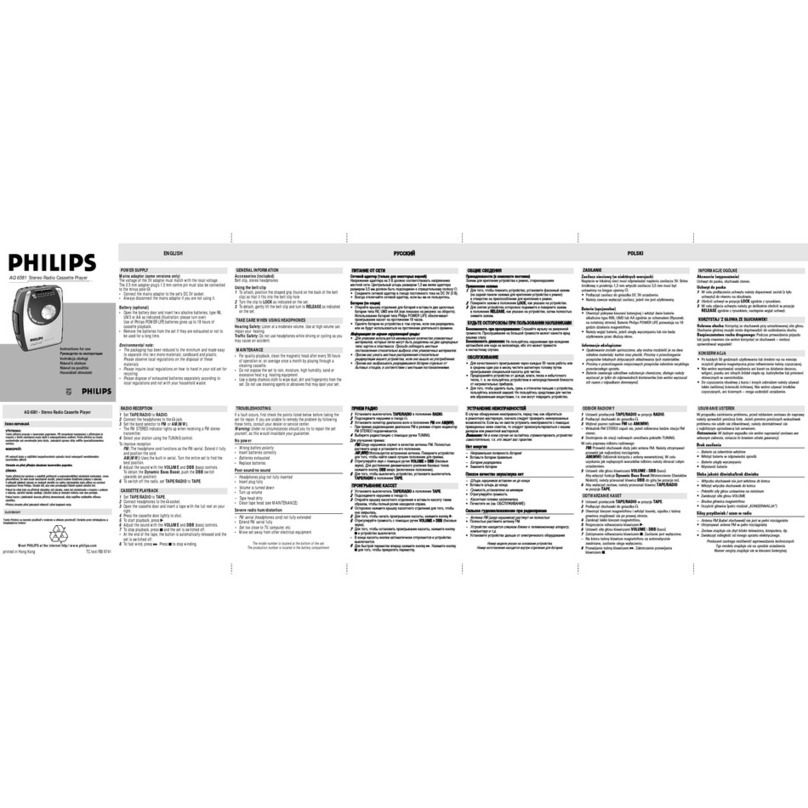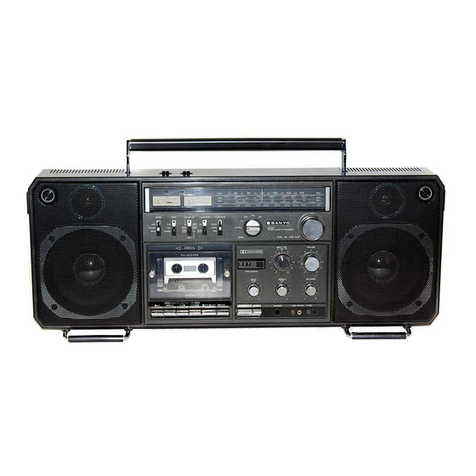TEAC PROFESSIONAL TASCAM 302 User manual

www.SteamPoweredRadio.Com
TASCAM
TEAC
Professional
Division
Double Auto Reverse Cassette Deck
~
302
o o
··
•-"··-
•
g
I
□
I
-E/E/
.
BEi
.
-E/E/
.
E/E/
,
I
□
I
cif
0
II
I J
II
..
...
,
..
...
..
.
,
..
...
11
I I
I 0
a11
mMmM111111N1111Hm
•
111mn1m
•m11m111m
•
mmm1111m111m111111
•
111m1t1111N1111m1111m
...
....
,.-
(
1•2
)-.
6
~·
0 ~
o
=-
-o- o
..
-
"'
- -
D
CJ
CJ CJ
CJ CJ
D
-~-
··-
..
··-
---
-~-
I
----
1
""
:::::'.,
T-
,-~
·"
---·2
@
0
••
•-
-o~ o~ o- o-
~
-:
@- -@-
~
••
"~
•-
o
~..
o
~..
o
-•
o
•-
0
I
I
EJEJ
0
GJ8
1EU~
]\
l~I l~I
/
I
EJEJ
0
GJ8
1l0 00 1
I
L...J
L...J
(
___
OW_N_E_R'_S_M_A_N_U_A_L
__
)
9101402600
Manuel Français Included
Deutsch Handbuch Enthalten

www.SteamPoweredRadio.Com
2
THE APPLIANCE CONFORMS WITH EEC DIREC-
TIVE 87/308/EEC REGARDING INTERFERENCE
SUPPRESSION.
CONFORME AL D.M. 13 APRILE 1989
DIRETTIVA CEE/87/308
Bescheinigung des Herstellers/lmporteurs
Hi
ermit wird beschei
ni
gt,
daB
der/die/das
Doppelcassetten-Recorder 302
(Gerat, Typ, Bezeichnung)
in
Ubereinstimmung
mi
t den Bestimmungen der
AMTSBLATT
163/1984
,
VFG
1045/1984,
VGF
1046/1984
(AmtsblattverfOgung)
funk-entstort ist.
Der Deutschen Bundespost wurde das
ln
verkehrbringen dieses
Gerates angezeigt und die Berechtigung zur Uberprufung der
Serie auf
Ei
nhaltung der
Be
stimmungen eingeraunt.
TEAC CORPORATION
Name des Herstellers/lmporteurs
VOLTAGE CONVERSION
NOTE :
Vo
lt
age conversion
is
not possible on models
sold
in
the U.K., Austra
li
a or Europe.
VOLTAGE
SELECTOR
230V
120V
I I
0
[]]
0
0
'2::rri
0
Be sure to remove
th
e power cord from
th
e AC outlet
before repositioning the voltage converter switch.
I. Locate the voltage selector on
th
e rear panel.
2. Using a flat-bladed screwdriver, set to the appropriate
230 V
or
120 V position according to your area.
IN
NORTH AMERICA USE ONLY
ON
120 V SUPPLY.
DANS L'AMERIQUE
DU
NORD: UTILISABLE SUR 120 V
D'ALIMENTATION UNIQUEMENT.
For
CANADA
-----------
----------
---
---~
AC POWER CORD CONNECTION
CAUTION:
CORDE DE CONNEXION CA
ATTENTION:
TO PREVENT ELECTRIC SHOCK, MATCH WIDE
BLADE OF PLUG TO WIDE SLOT, FULLY INSERT.
POUR
EVITER
LES
CHOCS
ELECTRIQUES
,
INTRODUIRE
LA
LAME
LA
PLUS LARGE
DE
LA
FICHE DANS LA BORNE
CORRESPONDANTE
DE
LA
PRISE
ET
POUSSER JUSQU'
AU
FOND.
A
A
CAUTION:
TO
REDUCE
THE
RISK
OF
ELECTRIC
SHOCK,
DO
NOT
REMOVE
COVER
(OR
BACK).
NO
USER-SERVICEABLE
PARTS
INSIDE.
REFER
SERVICING
TO
QUALIFIED
SERVICE
PERSONNEL
.
The
lightning
flash
with
arrowhead
symbol,
within
equilateral
triangle,
is
intended
to
alert
the
user
to
the
presence
of
uninsulated
"dangerous
voltage"
within
the
product
's
enclosure
that
may
be
of
sufficient
magnitude
to
constitute
a
risk
of
electric
shock
to
person
.
The
exclamation
point
within
an
equilateral
triangle
is
intended
to
alert
the
user
to
the
presence
of
important
operating
and
maintenance
(servicing)
instructions
in
the
literature
accompanying
the
appliance
.
This
appliance
has
a
serial
numb
er
loc
ated
on
the
rear
pa
nel.
Please
record
the
model
number
and
serial
number
and
retain
them
for
your
records.
WARNING:
TO
PRIVENT
FIRE
OR
SHOCK
HAZARD,
DO
NOT
EXPOSE
THIS
APPLIANCE
TO
RAIN
OR
MOISTURE.
Model
number
______
_
Serial
number
__
_____
_

www.SteamPoweredRadio.Com
Safety Instructions
CAUTION:
• Read all of these Instructions.
• Save these Instructions for later use.
• Follow all Warnings and Instructions marked
on
the audio
equipment.
1)
Read instructions -All the safety
and
operating
in
structions
should be read before the product is operated.
2)
Retain instructions -
The
safety
and
operating
instructions
should be retained for future reference.
3)
Heed
Warnings
-
All
warnings
on
the
product
and
in
the
operating instructions should be adhered to.
4) Follow instructions -All operating and use instructions shoud
be followed.
5)
Cleaning
-
Unplug
this
product
from
the
wall
outlet
before
cleaning
. Do not use liquid
cleaners
or
aerosol cleaners. Use a
damp
cloth for cleaning.
6) Attachments -Do not use attachments not recommended by the
product manufacturer as they may cause hazards.
7) Water and Moisture -Do not use this product near water -for
example,
near
a bath tub, wash bowl, kitchen sink,
or
laundry tub;
in
a
wet basement;
or
near
a swimming pool; and the like.
8) Accessories -Do not
place
this
product
on an
unstable
cart,
stand, tripod, bracket,
or
table.
The
product may fall, causing serious
injury to a child
or
adult, and serious damage to the product. Use only
with
a
cart,
stand,
tripod,
bracket,
or
table
recommended
by
the
manufacturer,
or
sold with the product. Any mounting
of
the product
should
follow
the
manufacturer
's
instructions,
and
shou
ld
use
a
mounting accessory
recommended
by the manufacturer.
9) A product and cart combination should be moved with care. Quick
stops, excessive force, and uneven surfaces may cause the product and
cart combination to overturn.
~c,
~
10) Ventilation -Slots and openings
in
the cabinet are provided for
ventilation and to ensure reliable operation
of
the product and to protect
it
from
overheating,
and
these
openings
must
not
be
blocked
or
covered.
The
openings should
never
be blocked by placing the product
on a bed, sofa, rug,
or
other similar surface. This product should not be
placed
in
a built-in installation such as a bookcase
or
rack unless proper
ventilation
is
provided
or
the
manufacturer's
instructions
have
been
adhered to.
11}
Power Sources -
This
product
should
be operated only from
the type
of
power source indicated on the marking label.
If
you are not
sure
of
the type
of
power
supply to your home, consult
your
product
dealer
or
local
power
company.
For
products intended to operate from
battery power, or other sources, refer to the operating instructions.
12) Grounding or Polarization -This procuct may be equipped
with a polarized alternating-current line plug (a plug having one blade
wider than the other). This plug will fit into the
power
outlet only one
way. This
is
a safety feature. If you are unable to insert the plug fully
into the outlet, try reversing the plug.
If
the plug should sti
ll
fail to
fit
,
contact your electrician to replace your obsolete outlet. Do not defeat
the safety purpose
of
the polarized plug.
13) Power-Cord Protection -Power-supply cords shoud be routed
so that they are not likely to be walked on
or
pinched by items placed
upon
or
against
them
,
paying
particular
attention
to
cords
al
plugs
,
convenience receptacles, and the point where they exit from the product.
14) Outdoor Antenna Grounding -
If
an outside antenna
or
cable
system is connected to the product, be sure the antenna
or
cable system
is
grounded so as to provide
some
protection against voltage surges and
built-up
static
charges.
Article
810
of
the National Electrical
Code,
ANSI/NFPA 70, provides information with regard to proper grounding
of
the mast and support
in
g structure, grounding
of
the lead-in wire to an
antenna
discharge
unit
,
size
of
grounding
conductors,
location
of
antenna-discharge
unit,
connection
10
grounding
electrodes,
and
requirements for the grounding electrode.
"Note
to
CATV system installer:
This reminder is provided to call the CATV system
in
staller's attention
to
Section
820-40
of
the
NEC
which provides
guidelines
for
proper
grounding
and,
in
particular
,
specifies
that the
cable
ground
shall
be
connected to the grounding system
of
the building, as close to the point
of
cable entry as practical.
Example
of
Antenna
Grounding
as per
National Electrical Code, ANSI/NFPA
70
NEC
-
NATIONAL
ELECTRICAL
CODE
ANTENNA
LEAD
IN
WIRE
ANTENNA
DISCHARGE
UNIT
(NEC
SECTION
810-20)
J--+-.
...:.:::::,...--1.GROUNDING
CONDUCTORS
(NEC
SECTION
810
-21)
15) Lightning -
For
added
protection
for
this
product
during
a
li
ghtning
storm,
or
when
ii is left
unattended
and
unused
for
long
periods
of
time
,
unplug
it
from the
wall
outlet
and
disconnect
the
antenna
or
cable system. This will prevent
damage
to the product due to
lightning and power-line surges.
16) Power Lines -An outside antenna system should not be located
in
the vicinity
of
overhead power lines
or
other electric light
or
power
circuits,
or
where
it
can
fall into such
power
lines
or
circuits.
When
installing an outside antenna system,
extreme
care should be taken to
keep from touching such
power
lines
or
circuits as contact with them
might be fatal.
17) Overloading -Do not
over
load wall outlets, extension cords, or
integral
convenience
r
ecep
tacles
as this
can
result
in
risk
of
fire
or
electric shock.
18) Object and Liquid Entry -Never push objects
of
any kind into
this
product
through
openings
as they
may
touch
dangerous
voltage
points
or
short-out parts that
could
result in a fire
or
electric
shock.
Never spill liquid
of
any kind on the product.
19) Servicing -Do not attempt to service this product
yourself
as
opening
or
removing covers may expose you to dangerous voltage
or
other
hazards. Refer all servicing to qualified service personnel.
20) Damage Requiring Service -
Unplug
this product from the
wall outlet and refer servicing to qualified service personnel under the
following conditions:
a) when the power-supply cord
or
plug
is
damaged.
b)
if
liquid has been spilled, or objects have fallen into the product.
c)
if
the product has been exposed to rain or water.
d)
if
the product does not operate
nom,ally
by following the operating
instructions.
Adjust
only
those
controls
that
are
covered
by
the
operating instructions as an improper adjustment
of
other
controls may
result
in
damage
and will often require extensive work by a qualified
technician to restore the product
10
its normal operation.
e)
if
the product has been dropped or damaged
in
any way.
f ) when the product exhibits a distinct change
in
performance -this
indicates a need for service.
21) Replacement Parts -When replacement parts are required, be
sure the service technician has used replacement parts specified by the
manufacturer
or
have
the
same
characteristics
as the
original
part.
Unauthorized substitutions may result
in
fire, electric shock,
or
other
hazards.
22) Safety Check -Upon completion
of
any service
or
repairs
10
this
product
, ask the
service
technician
10
perform
safety
checks
to
determine that the product is
in
proper operating condition.
23) Wall or Ceiling Mouting -
The
product
shoud
be mounted
10
a
wall
or
ceiling only as recommended by the manufacturer.
24) Heat -
The
product should
be
situated
away
from heal sources
such as radiators, heal registers, stoves,
or
other products (including
amplifiers) that produce heat.
3

www.SteamPoweredRadio.Com
IMPORTANT (for U.K. Customers)
DO
NOT
cut
off
the
mains
plug
from
this
equipment.
If
the plug fitted
is
not suitable for the
power points
in
your home or the cable is too short
to reach a power point, then obtain
an
appropriate
safety approved extension lead or consult your
dealer.
If
nonetheless
the
mains
plug
is
cut
off.
remove
the
fuse
and
dispose
of
the
plug
immediately, to avoid a possible shock hazard by
inadvertent connection to the mains supply.
If
this product
is
not provided with a mains plug, or
one has to be fitted. then follow the instructions
given below:
IMPORTANT. DO NOT make any connection to
the larger terminal which is marked with the letter
E or by the safety earth symbol
~
or coloured
GREEN or GREEN-and-YELLOW.
The wires
in
the mains lead
on
this product are
coloured
in
accordance with
th
e following code:
BLUE: NEUTRAL
BROWN:
LIVE
As these colours may not correspond with the
coloured markings identifying the terminals
in
your
plug proceed as follows:
The
wire
which
is
coloured
BLUE
must
be
connected to the terminal which
is
marked with the
letter N or coloured BLACK.
The
wire
which
is
coloured
BROWN
must
be
connected to the terminal which is marked with the
letter
Lor
coloured RED.
When replacing the fuse only a correctly rated
approved type should be used and
be
sure to re-fit
the fuse cover.
IF IN
DOUBT
-
CONSULT
A
COMPETENT
ELECTRICIAN.
Introduction
The
TASCAM
302
is a
double
auto reverse
cassette
deck
prim
arily
designed
for
continuous
playback
of
background music
or
tape dubbing needs. A maximum
of
ten
3O2s
can
be hooked up to
fom1
a sequential
pl
ay
loop
or
to
synchronize
them, with one serving as the
ma
ster/
source
machine
and the
others
serving
as the
slave/target machines, for simultaneous tape dubbing.
Optional Accessories :
o RC-3O2 remote control unit
o
WR-7OOO
synchro cable (for interconnecting two or
more 3O2s, as shown on pp.
12
and 13)
o TZ-261 cleaning kit (except for U.S.A.)
o HC-1 head cleaner
&
RC-I rubber cl
eaner
(U.S.A.
only)
o Head demagnetizer
Table of Contents
General Guide to the Controls and Connectors ........5
Using a Single 302 ........................................................8
Recording on either deck,
or
both at the
same time...
..
....
....
................................
..
................
8
Continuous recording on both decks .........................9
Dubbing from deck
I
onto deck 2 ............
....
.............9
Playback........
..
..............................................
..
.......
..
10
Using
just
one
of
the two available decks ...........
10
Continuous play on both decks .................
..
........
10
Using the CPS function.....
..
................
..
.
..
................ I I
Erasing recordings .................................................
..
11
Multiple-302 System Operation .................................
12
Sequenti
al
link play .....
..
.....
..
...................................
12
Simultaneous dubbing onto multiple
cassettes ...................
..
.........................................
13
Recording an external source onto multiple
cassettes simultaneous
ly
......................................
15
Recording separate sources onto separate
multiple cassettes sequentially
..
..
........................
16
Care and Maintenance................................................16
Troubleshooting..........................................................17
Error Messages ........................................................
17
Specifications..............................................................18
Block Diagram.........................................................
19
Rack Mounting
The
302 can be installed
in
a standard 19" rack, using
the provided 4 pairs
of
screws (MS x12) and washers, as
-
tor
In
je,
In
)rd
the
the
hts
on
xd
lay
1es
rse
If
1to
wn
fo.
ted
md
1ile
+/-
~or
:he
shown. .nd
C
en
ng
~
1
0n
ies
&
are
4

www.SteamPoweredRadio.Com
General Guide to the Controls and Connectors
0
0
0
0
5
1
2
345
6 7 8 9
4 3 2
5
101112
'jf,,l."":!~,',
]
30
!
co
co
~
,..,
~
I
-
BB
BEi
. -
BB
.
El
~. I
Cl}-
I
I I
f-@
•
nmnm
111111111111111
•
111111111111111111
mum
I
i
I
I
•
1111111111
11101111nm
•
111111111111111111
11111111
I
~
~
I
-
~ff
S!
l
l.,
1)
-.
~
~•
o
:~
o
:~
" o-
Q1t1
-m
~·
H!J
C~
C:
□
CD
CE-
,
. .
~ •
=~',-~
~•
a , -
~-=-~
I
CClii] O
c'CJJ
cc
m .
B
H)
IRECTIOH:Al R
ECOROIP't.
AV
2
(/;.):.
81
·
-CTIONAI..MCOfl'O
l"'-AY
1 - •
1 I - • '.::=.-'
U
•-
-
Q
~•
Q M
o- o- «'~
~
1~
-~@'- «'5
~-
" -
"
""
0"'-
AT
Q
.,._
AY
Q
MU
SE QlllCORO
• •
'-=
' ,
_,.
• • • I
<\"
1•
►
11
II
◄
I 1111
11
101
II \
~~
I I
~~
~
,.11
·'"
11
■
II
◄
II
►
II •
L
"""""
L
J
20 22
24
I
24
22
20
13 14 15 17
16 18 19
21
23
25
26
21
13
14 15
17 16 18 19
/
"'""
"c
-
I
c
m•D<
"'""'
m
R
EfrllOTE
IMPUT
OUTPUT
_,,..,...,,""""'
c"""'°'
c
"""'°'
' 1(@) @) ,
,
K@
)
@1
(@)
1,
,.
""'
·@
O·
" '@
I~
1~
2-:.
@ @
<p
L....J
29
30
31
32
33
6
----.
5m (about
15
feet)
long
7
--
tt-~;:....;;;;;;;;;-
34
--
-tt--'-,
r-
-+t--
--
3
13 4
14
--
-1+~~
35
17 19
16 18
15 3
34
4
13~-;::::::~ ~
35
14
19
17
18
16
--
- - ~ 15
TASCAM
RC
·
302
REMOTE
C0NTROl
UNIT
(Optional)
I~
-
L....J
27
0 d -
-+-
-1111111111111111111111111111
•1111111111111111111111111111
•1111111111111111111111111111
•1111111111111111111111111111
28
C
-
0
0
0

www.SteamPoweredRadio.Com
Front Panel
1.
POWER switch:
Tums the unit on and off.
2.
Cassette Compartment :
Opens upon pressing
the
EJECT
button.
3.
RTZ (Return-To-Zero) button :
Fast-winds the
tape
to
a
zero
reference
point
selected
by
pressing
RESET. You can press PLAY after RTZ for the tape to
automatically
start
playing
at the
end
of
the
search
function.
If
PA
USE
is
pressed instead
of
PLAY, the deck
goes into Play Ready mode.
The
tape
will
go
slightly
past
the
0000
point
on the
counter because
of
inertia.
RTZ cannot operate unless
it
is
pressed when the tape
counter reads 0003 or higher numbers.
4.
RESET button :
Resets the counter to 0000 to mark
any point on the tape which you can access
by
pressing
RTZ.
5.
EJECT button :
Opens the cassette compartment.
6.
DUAL REC button :
If pressed when the tape is
stopped, puts both decks into Record Ready mode_; and
pressing PLAY on either deck starts recording via deck
I's
input.
This
function
is
used
only
for
single
302
operation.
7.
SYNC REVERSE switch :
Used for tape dubbing,
causing
two
or
more
tapes
to be
switched
to
their
reverse sides
in
synchronization with each other.
8.
CPS switch :
Can be operated while
in
Stop, Play
Ready, and Play modes to access specific programs on
the tape.
9.
DUB STDBY switches:
In
NORM mode, you can
locate the source tape to the point you want to next start
dubbing from, while keeping the target tapes waiting at
the end
of
the previous recording.
You
can't do this
in
HI
SPEED
mode.
10. PHONES OUT switch :
Selects
a
headphone
monitor
so
urce.
Set
to I for
monitoring
tape
signals
from deck I, 2 for monitoring tape signals from deck 2,
or
MIX
for
monitoring
a
mix
of
two
tape
signals.
During
Record
Ready
or
Record
modes,
you
can
monitor input signals, as selected with this switch.
11.
PHONES control :
Adjusts the listening level
of
the headphones plugged into the PHONES jack.
6
12. PHONES jack :
For
connection
to 3-conductor
stereo headphones.
13. REW button :
Winds the tape at high speed
in
reverse.
When
pressed
while
in
Play
Ready
mode,
offers cueing to an earlier point.
14. F FWD button :
Winds the tape at high speed
in
the forward direction.
When
pressed while
in
Record
Ready mode, offers forward cueing.
15. STOP button :
Used to stop the tape and exit the
current operation modes.
16.
PLAY
(
►
)
button :
Plays the forward side
of
the
tape. The associated
LED
blinks during Stop, and lights
steadily during Play Ready and Play.
If pressed when the tape
is
ready for record or play on
the reverse side, switches the tape to be ready for record
or play on the forward side.
17.
PLAY
(
◄
)
button :
Similar to the forward play
button, but plays the reverse side
of
the tape or switches
the tape to be ready for record
or
play
on
the reverse
side.
18. PAUSE button :
Interrupts
record
or
play. If
pressed
when
the tape is
stopped,
puts the deck into
Play
Ready
mode.
If
pressed
while
holding
down
RECORD,
puts
the
deck
into
Record
Ready
mode.
Recording starts upon pressing
PLAY-the
associated
LED
of
which
is
lit.
19. RECORD button :
Holding down this button and
pressing PLAY starts recording. Pressing STOP while
holding down
RECORD
records a 4-second silence.
20. PITCH CONT knob :
Varies play speed
about+
/-
1
O % to match pitch
or
to produce special effects. For
normal play operation, be sure to set this knob to the
center position.
21. REC BAL knob :
Used to balance the left and
right input levels.
22. DOLBY NR switch :
Selects the Dolby B or C
Noise
Reduction
system
or
defeats
them.
When
listening to a recording,
set
this switch to the setting
used for the original recording.
Dolby
noise
reduction
and
HX
Pro
headroom
extensi_on
manufactured
under
license
from
Dolby
Laboratones
Licensing
Corporation.
HX
Pro
originated
by
Bang
&
Olufsen.
"DOLBY",
the
double-D
symbol
□□
and
"HX
PRO"
are
trademarks
of
Dolby Laboratories Licensing Corporation.

www.SteamPoweredRadio.Com
23.
REV MODE switch :
In
non-reverse mode (
::::::::
),
the tape stops recording
or
playing at the
end
of
the
current tape side.
In reverse mode
(
C--=>
),
both sides
of
the tape continue to
play
over
and
over
until you press STOP.
Recording
automatically continues from the forward
side
of
the
tape
to the
reverse
side,
stoppi
ng
at
the
end
of
the
reverse side.
If
started from the reverse side, recording
stops
at
the
end
of
that
side
-the
same
as in non-
reverse mode.
The
CONT
position
is
for continuous play
or
record
from deck I to deck 2 with either a single
or
multiple
302 system.
24. INPUT controls :
Adjust
record
level for the
individual deck
I
and deck
2.
25.
SLV/MSTR switch : Normally, leave this switch
OFF. Only when dubbing a tape onto,
or
recording from
an external single source on multiple 302s, select SLY
orMSTR.
26.
INPUT/OUTPUT switch : Set to SEPARATE for
deck I and deck 2 to operate independently from each
other. With SEPARATE engaged,
th
e inputs and outp
ut
s
on the rear panel are independent for each deck. Only in
DUAL
REC
mode, the inputs to deck I have access to
deck 2 as well.
In
COMMON
mode,
the F
FWD,
REW,
STOP,
or
PLAY PAUSE buttons have the
same
effect on both
deck I and deck 2, simultaneousl
y.
But,
if
deck I is
playing and you press PLAY on deck 2, deck I stops.
Only the inputs and outputs on deck I can be used.
27.
Tape Counter : Indicates
in
minutes and seconds
the elapsed time from any point on the tape selected by
RESET.
NOTE
The tape counter
is
not a watch. The reading
on
the tape counter is affected by the tape length,
re
el
hub diameter, a
nd
other mechanical factors.
28.
Peak Level Meters : Indicate tape signal levels
during playback,
or
input levels during Record Ready
and Record modes.
Rear Panel
29.
DECK 2, INPUT and OUTPUT jacks : These
jacks are independent from deck I all the time.
30. DECK
1/COMMON,
INPUT
and OUTPUT
jacks :
When
the
INPUT
/
OUTPUT
switch is set to
COMMON, inputs to deck
I
are taken into deck 2 as
well, and outputs from deck 2 are sent to the deck
l's
output jacks as well.
31. CASCADE OUTPUT jacks : Used for dubbing
from a deck onto,
or
recording from
an
external single
source on multiple decks, as shown
in
the diagram on
page
13.
32.
EXT
CONTROL
jack
:
Used
to
connect
a
multiple-302 system, as shown in the diagram on page
12.
33. REMOTE CONTROL jack :
For
connection to
the optional remote control (RC-302).
RC-302 Remote Control Unit (Optional)
34.
CPS buttons : Can operate when the transport
is
in
Stop, Play Ready
or
Play modes to access specific
programs on the tape. See also
Using the CPS Function,
page
11.
35.
REC
MUTE button :
You
can terminate recording
by
pressing
this
button.
A
4-second
silence
is
then
recorded to the end
of
the recording. After this interval,
the deck goes into Record Ready mode.
All the other controls on the remote are duplicates
of
the
correspond
in
g controls on the 302 unit.
NOTE
The remote unit is powered from the 302 unit.
Don't attempt to open the lid
on
the remote unit.
7

www.SteamPoweredRadio.Com
Using A Single 302
Recording on Either Deck, or Both
at
the Same Time
REC
BAL
~
L R
8
EJECT
c:::J]
RESET
D
REV MODE
=
C""~
CONT
cmmJ
INPUT
/OUTPUT
SEPARATE
COMMON
~
DOLBY
NR
OFF
B C
,u,
-'
6
12,UAL
/
□
10001
-~@-
[:]]
Unless you use multiple 302s connected
in
series, set the
OFF
/SLV/MSTR switch to
the left
OFF
position all the time.
1.
Check to see that the source
is
connected to the DECK 1 INPUT connectors if you
intend to record on deck I only
or
on deck 1 and deck 2 simultaneously. Use the
DECK 2 INPUT connectors if you intend to record on deck 2 only.
2.
Press POWER to turn on the unit.
3. Press
either
or
both
EJECT
buttons to open the cassette
compartments,
insert
cassettes, and close the compartments.
4. Press
either
or
both
RESET
buttons
so
you
can
use the RTZ (return-to-zero)
function to locate the record start point.
5. Make the following switch settings :
REV MODE switch to
:::::::
if you intend to record on one side
of
the tape(s) only
or
C-....) to record on both sides continuously ;
INPUT/OUTPUT switch to SEPARATE ;
DOLBY NR switches to the desired position.
6.
If
you intend to record on both deck I and deck 2 simultaneously, press the DUAL
REC button. Its LED will turn on
arrd
both decks wilrgo into Record Ready mode.
If
you are using only one
of
the two decks, put
it
into Record Ready mode by
holding down RECORD and pressing PAUSE.
7. Start the external source and adjust the INPUT control(s) so that the meter reading
is
around OdB. Use the REC BAL control(s) to balance the left and right input
levels.
8. To start recording, press PLAY on the deck
in
use.
If
DUAL
REC
is
activated, you
can press PLAY on either deck to start recording on both decks.
o
To
stop recording, press STOP.
If
DUAL REC
is
activated, you can press STOP on
either deck to stop both tapes.
The
DUAL REC LED will then turn off.
o To audition the recording just completed, press RTZ, then press PLAY for the deck
whose LED
is
blinking.
Suggestion : You can record a 4-second silence by holding
down
RECORD and
pressing STOP (or by pressing the remote REC MUTE button) after program material
has been recorded. The CPS (Computomatic Program
Search)
function (discussed
below) identifies specific programs by counting a blank space
of
4 seconds
or
more
between programs.

www.SteamPoweredRadio.Com
Continuous Recording on Both Decks
When the tape on deck I records
up
to the end
of
the reverse side, the tape on deck 2
will start recording, stopping at its end
of
the reverse side.
The procedure
is
essentially the same for Recording on Either Deck, or Both at the
Same Time, except :
o The _REV MO
DE
switch must be set to CONT.
DUAL REC cannot be used
in
this application ; put both decks into Record Ready
mode separately by holding RECORD and pressing PAUSE on the individual decks.
(The INPUT and REC BAL controls and the DOLBY NR switch also must
be
set on
the individual decks.)
Dubbing from Deck 1 onto Deck 2
REV
MODE
=
C--.:>
CONT
~
\
,r:;,
oue
ST
DB
Y(
1
►
2)-,
-
v-N
ORM
Q
HI
S
PE
ED
"b
c::::J
'I
~Y
NC
15SE
If
you want to use an
amp/speaker
system to monitor the source tape as it plays,
connect your monitor system to the output
of
deck
1.
1.
Insert the source tape into deck I and a target tape into deck
2.
2.
Locate the source tape to the beginning
of
the program material you intend
to
dub,
and the target tape to the point you want to start recording from.
3. Set the REV MODE switch to
==
to limit dubbing to one side only
or
C-...)
for
dubbing to continue onto the reverse side automatically.
4.
Press the DUB
STDBY
NORM
button if you intend to dub selected portions or
materials.
Use the HI SPEED mode when dubbing the entire tape without interruption.
Upon selecting either DUB STDBY mode, deck I goes into Play Ready mode, and
deck 2 goes into Record Ready mode.
At this moment, PLAY, STOP, F FWD and REW can operate on deck 1 if
in
NORM
mode.
In
HI SPEED mode, only PLAY can operate
to
change the record direction
(STOP can also operate but only serves to disengage the dubbing mode).
5.
If
you have connected a monitor speaker system to the output
of
deck I, and have
selected the HI SPEED mode, set the INPUT/OUTPUT switch to SEPARATE.
6.
Press the SYNC REVERSE button if you want whichever tape first reaches the end
of
the forward side to
go
into Play Pause or Record Pause mode (depending on
whether the tape
is
the source or target), thus waiting for the other tape to reach its
end
of
the forward side, so that both tapes are simultaneously switched to start their
respective functions on their reverse sides.
SYNC REVERSE can function only when :
I.REV MODE
is
set to
C-
...)
;
2.DUB STDBY
is
pressed before SYNC
REVERSE;
and
3.Both tapes start from their forward sides.
9

www.SteamPoweredRadio.Com
[:]
STOP
8
Playback
Using Just One of the
Two Available Decks
REV
MODE
=
C-.:>
CONT
cmtiJ
DOLBY NR
Off
8 C
1&1
[:]
Continuous
Play
on
Both Decks
10
INPUT/0\JTP\JT
SEPARATE
COMMON
~
REV
MODE
=
C--=>
CONT
cmfm
DOLBY NR
OFF
B C
[jijfJ
[:]
7.
To
start dubbing, press the
forward PLAY
button on deck 2.
8.
If
you are
in
NORM mode :
When dubbing
of
a selection is complete, locate the tape to the beginning
of
the
next selection to dub. When you press
PAUSE, STOP, F FWD
or
REW
on deck I,
deck 2 invariably goes into Record Pause mode.
You
can press
PAUSE
on deck 2 to put deck I into Play Pause mode and deck 2
into Record Pause mode.
9. To stop dubbing
in
NORM mode and exit this mode, press
STOP
on deck 2.
In
HI
SPEED
mode, you can press
STOP
on either deck.
I.
Connect
the
amp/speaker
system to the
OUTPUT
connectors
of
the deck you
intend to use.
2. Insert the tape into either deck I
or
2.
3. Make the following switch settings :
o
REV MODE
switch to
=::::
to play only one tape side
or
C"'"-.:>
to play both sides
continuously.
o
DOLBY NR
switch depending on the tape
in
use.
If
REV
MODE
is
set to
=::::
and you intend to play only the reverse tape side, press
the
reverse PLAY
button to have the associated LED start blinking.
4.
To
start play, press
PLAY
whose LED is blinking.
You
can
either
connect
a single amp/
speaker
system to the
deck
I's
output
or
an
additional amp/speaker system can be connected to the deck 2's output as well.
To
have both decks play sequentially :
I. Set the
INPUT/OUTPUT
switch to SEPARATE
if
both decks' outputs are
in
use
or
COMMON
if
only deck I's output
is
in
use.
2. Set the
REV MODE
switch to CONT.
3. Insert the tapes into both decks.
4. Set the
DOLBY NR
switch on both decks depending on the tapes
in
use.
5.
To
start sequential play, press
PLAY
on deck I.

www.SteamPoweredRadio.Com
Using the CPS Function
CPS
~
F FWD
EJ
,-
CPS---,
1~1
1111+11
Erasing Recordings
When deck 1 plays up to the end
of
the reverse side, deck 2 automatically sta
rt
s
playing. When deck 2 plays up to the end
of
the reverse side, deck
1
again starts
playing. This process continues until you press
STOP
on either deck.
CPS (Computomatic Program Search) autolocates the tape to the beginning
of
specific
program
materials.
The
tape
will
automatically
start
playing
after
completing
autolocation.
To identify specific programs, CPS counts a blank space
of
about 4 seconds between
programs.
To
access a program on the other side
of
the tape, the
REV MODE
switch must be set
to
C"".-:>
•
I.
2.
When the tape
is
stopped
or
is
playing
or
is
in
Play Ready, press the
CPS
button.
The tape counter will
be
switched to read
CPO
1.
To
autolocate
the tape, say to the fifth
program
ahead,
press the
CPS
button
repeatedly until 05
is
displayed. Then, press
F FWD.
If
you press
REW
instead
of
F
FWD,
the tape will be autolocated to the fifth
program back.
If
you are using the optional remote control :
The instant either
CPS
button
is
pressed once, the search function starts. Press the
button the necessary number
of
times running while the tape
is
running.
Turn the
INPUT
control all the way to the left and put the deck into Record mode.
To
erase the entire tape (except metal tapes), we recommend that you use the optional
bulk erasure device (TEAC E-2A).
11

www.SteamPoweredRadio.Com
Multiple-302 System Operation
Sequential
Link
Play
OFF
SLY
MSTII
miiEJ
12
A
maximum
of
ten ( I0)
302s
can
be
interconnected
to
provide
the
following
possibilities :
o Sequential link play
of
multiple cassettes.
o Dubbing onto multiple cassettes simultaneously.
o Recording an external source onto multiple cassettes simultaneously.
o Recording separate sources onto separate multiple cassettes sequentially.
WARNING : Make all connections with power off.
DECK 2
DECK
1 /
COMMON
I
CASCAOE
EXT
REMOTE
INPUT
OUTPUT
INPUT
OUTPUT OUTPUT
CONTROl
CONTROL
,oo,
,o
O o,
OUT
RO
OR
RO
010R
(§)
WR-7000
DECK 2
DECK
1 /
COMMON
I
CASCAOE
T
REMOTE
INPUT
OUTPUT
INPUT
OUTPUT OUTPUT
CD
ROL
CONTROL
,o
o,
,ooo,
IN
OUT
RO
OR
•O
010•
(§)
WR-7000
DECK 2
~CiOMMili~
T
REMOTE
INPUT
OUTPUT
C
ROL
CONTROL
,o
o,
IN
RO
OR
·O
010R
Each time one cassette plays up to the end
of
the reverse tape side, the next cassette
wi
II
start.
1. Check to see that all the 302s are turned off.
2.
Refer to the diagram above, and connect the first 302
1
s
EXT
CONTROL OUT to
the second 302's
EXT
CONTROL IN, the second 302
1
s
EXT
CONTROL OUT to
the third 302's
EXT
CONTROL IN, and so on. Finally, connect the last 302
1
s EXT
CONTROL
OUT
to the first 302's
EXT
CONTROL
IN.
3. Switch on power to all the 302s.
4.
Make the following switch settings on each 302 :
o OFF/SLV/MSTR switch to OFF ;

www.SteamPoweredRadio.Com
REV MOOE
=
C--:>
CONT
~
[:]]
STOf>
0
o REV MODE switch to CONT.
5. Insert pre-recorded tapes into decks I and 2
of
every 302.
6.
To
start sequential link play, press
PLAY
on either deck
of
any 302.
7.
To
stop play, press
STOP
on the deck which is currently
in
play.
Simultaneous
Dubbing
onto
Multiple Cassettes
OFF
SLY
MSTR
cmII[)
REV MODE
=
C-.:1 CONT
cmII[)
WARNING :
Make all connections with power off.
MASTER
DECK 2
INPUT OUTPUT
,o o ,
·O
O·
SLAVE 1
DECK 2
INP\IT OUTP\IT
,o o ,
·O O ·
LAST SLAVE
DECK 2
INP\IT
OUTP\IT
,
oo,
·O O ·
DECK 1 / COMMON
I
CASCADE
INPUT
OUTPUT OUTPUT
loo
l
·O 01
DECK 1 / COMMON
I
CASCADE
INPUT OUTPUT
0UTPUT
0
l
01
DECK 1 / COMMON
I
CASCADE
INPUT
OUTPUT OUTPUT
oo,
0 10 •
EXT
REMCJTl::
CONTROL
CONT
ROL
OUT
WR-7000
T
REll<ITT
C
ROL
CONTROL
IN
OUT
@
WR-7000
T
REll<ITT
C
ROL
CONTROL
IN
I.
Refer to the diagram above, and interconnect multiple 302s through the
EXT
CONTROL
OUT
and IN and the
CASCADE
OUTPUT
and
DECK
I
INPUT
connectors.
2. Sw
it
ch on power
to
each 302.
3.
Make the following
sw
it
ch settings :
o
OFF/SLV/MSTR
switch to MSTR on one 302, and SLY on all the other 302s
(any but only one 302 can be designated as the master) ;
o
REV MODE
switch to
C"-.:>
on each 302.
4.
Insert the source tape into deck I
of
the master 302, and target tapes into all the
other decks
in
use.
Suggestion :
There is no problem if there are slaves into which no tape
is
inserted.
13

www.SteamPoweredRadio.Com
14
REW
EI
,
t-
,,
DUB
$TOBY
(1
►
2)-,
-
Ofj0RM
O HI SPEED
"b
CJ
[:]
STOP
8
5.
If
the reverse PLAY LED
is
blinking on any slaves, press the forward PLAY button
on deck 2
of
the master unit.
If
the reverse PLAY
LED
is
blinking
on
deck
I
of
the
master
unit, press the
forward PLAY on that deck.
Bear
in
mind that,
in
a multiple-302 system, the transport control buttons on deck I
of
the master unit are independent from all the other decks, while the buttons on
deck 2
of
the master unit have effect on decks I and 2
of
every slave unit.
6.
If
need be, rewind
th
e source tape to the beginning with the REW button on deck I
of
the master.
Pressing the REW button on deck 2
of
the master rewinds all the target tapes to
their beginnings.
7. Press the DUB STDBY NORM
or
HI SPEED button on the master unit, as required.
For
an explanation, see steps 4 and 8 under the heading Dubbing From Deck J
Onto Deck 2.
Upon pressing either
DUB
STDBY
button, deck I
of
the
master
goes into Play
Ready mode, and all the other decks
go
into Record Ready mode.
If
you have pressed a
wrong
button
or
changed
your
mind and want to switch
NORM
to HI
SPEED,
or
vice versa, first press STOP on
deck
2
of
the master.
Then, press HI SPEED or NORM, as required.
8. Press the SYNC REVERSE button
on
the master unit.
•
The
LED
above the button will light steadily, while the same
LED
on all the slaves
will start blinking.
9. To start dubbing, press PLAY on
deck
2
of
the master unit. Deck 2
of
the master
and all the slave decks will go into Record mode, simultaneously.
The target decks all configure themselves to the Dolby system and the record level
settings used when originally recording the source tape. Settings
of
the
INPUT
and
REC
BAL
controls and the
DOLBY
NR
switch on the individual target decks are
overridden.
I0.To stop dubbing, press STOP on deck 2
of
the master.
NOTE
Upon pressing STOP
on
deck 1 or deck 2 of any slave 302, that deck cannot
function
any
more.
To
use it as a slave again, first press
EJECT.
Suggestion :
You
can hold down RECORD and press STOP on deck 2
of
the master to
record a 4-second silence
on
all the target tapes at the same time. Alternatively, you
can press the REC MUTE button for
deck
2
on
the remote control unit connected to the
master 302.

www.SteamPoweredRadio.Com
Recording an External Source onto Multiple Cassettes Simultaneously
REC BAL
OFF
SLY
IISTR
cimJ
REV
MODE
=
C""-=>
CONT
~
REW
B
100
0 1
·~@-
DOLBY NR
OFF
B C
1u1
[:]]
100
0 1
In
this application, deck I
of
the master 302
is
left unused.
I.
If
you
haven't
done
so
yet, interconnect the 302s, as
shown
on
page
13, then
connect the line output from the source unit to the DECK 2
INPUT
jacks on the
first 302.
2. Switch power
on
to all the 302s.
3.
Set the OFF/SLV/MSTR switch to
MSTR
on the 302 to which the source unit
is
connected, and SLY on all the other 302s.
4.
Set
the REV MODE switch to
:::::=
on each 302.
5. Insert cassette tapes into deck 2
of
the master unit and decks I and 2
of
the slaves.
Suggestion : There
is
no problem if there are slaves into which no tape
is
inserted.
6.
If
need be, locate the tapes to their beginnings
by
pressing the REW button on deck
2
of
the master unit.
7. Check to see that all the tapes are ready for recording
on
their forward sides, as
confirmed
by the forward PLAY
LED
blinking
on
the individual decks. If any
reverse PLAY
LEDs
are blinking, press the forward PLAY button on deck 2
of
the
master.
8. Hold down PAUSE and press RECORD on deck 2
of
the master. This puts all the
slaves into Record Ready mode.
9. Adjust the INPUT control on deck 2
of
the master so the meter reading
is
around 0
dB. Balance the left and right input levels with the REC BAL control.
I0. Set the DOLBY NR switch on deck 2
of
the master to the desired position.
All the slave decks configure themselves to the level and balance and the DOLBY
NR
settings
on
deck
2
of
the
master.
Settings
on
the
individual
decks
are
overridden.
11.
To
start recording, press the forward PLAY button on deck 2
of
the master.
If
the tape on deck 2
of
the master reaches the end
of
the forward side before any
tapes
on
the
slaves,
recording
continues
on
these tapes up to the end
of
their
forward sides.
You can interrupt recording on all the decks by pressing STOP on deck 2
of
the
master.
12
.When all the tapes reach the end
of
their forward sides, hold down RECORD and
press PAUSE on deck 2
of
the master to put all the decks into Record Ready mode.
15

www.SteamPoweredRadio.Com
ST
OP
13.Press the reverse PLAY button on deck 2
of
the master so that all the tapes are
ready for recording on their reverse sides.
14.
To continue
to
record, press the reverse PLAY button once more on deck 2
of
the
master.
I5. To terminate recording, press STOP on deck 2
of
the master.
Recording
Separate Sources
onto
Separate Multiple Cassettes Sequentially
This procedure
is
similar to the one for recording separate sources onto both decks
of
a
single 302. Summing
up
the points :
o Connect separate sources to decks I and 2
of
the individual 302s.
If you don't have done so yet, connect the first 302's EXT CONTROL
OUT
to the
second 302's EXT CONTROL IN, and the second 302's EXT CONTROL OUT
to
the third 302's
EXT
CONTROL in, and so on,
as
shown
in
the diagram on page 12.
o Make the following switch settings on each 302 :
INPUT/OUTPUT switch to SEPARATE ;
OFF/SLV/MSTR switch to
OFF;
RE
V MODE switch to CONT.
o Put the individual
decks
into
Record
Ready
mode
by hol
ding
RE
CORD
and
pressing PAUSE.
o
To
start recording, press PLAY on the deck you want to record on before any other
deck.
o
To
stop recording, press STOP on the deck which
is
currently
in
Record mode.
Care and Maintenance
Cleani
ng
the Heads and Tape
Gu
ides
All
heads
and metal
parts
in the tape path
must
be
cleaned
after
every
6
hours
of
operation,
or
before
starting and after ending a recording session.
I. Open the cassette compartment.
2.
Using a good head cleaning fluid and a cotton swab,
clean the heads and tape guides until the swab comes
off clean. Wipe off any excess cleaning fluid with a
dry swab.
16
Cleani
ng
the Pinch Rollers
Clean the pinch rollers at least once each day the deck
is
used. Use a good rubber cleaner.
I.
Clean the pinch rollers with a cotton swab moistened
with rubber cleaner, until there
is
no visible residue
on the pinch rollers.
2.
Using
a
clean
cotton
swab,
wipe
off
all
excess
runner cleaner from the pinch rollers. Make certain
that
there
is no foreign
matter
remaining
on
the
pinch rollers.

www.SteamPoweredRadio.Com
Cleaning the Capstan Shafts
After
cleaning
the
pinch roll
ers,
clean
the
capstan shafts
with acotton swab moistened with
head
cleaning fluid.
Degaussing the Tape Path
Slowly
move in to the tape path.
Move
the
degausser
slowly back
and
forth, touching
lightly
all metal parts in
the
tape
path.
Slowly
move
it
away again to
at
least I
mm
(3
feet) from
the
recorder before turning
if
off.
Troubleshooting
Problem Possible Cause
REV
MODE switch set
to:::=
or
c-.-:>.
Continuous record/play
impossible OFF/SLV/MSTR switch set to
SLV
or
MSTR.
Heads are dirty.
Poor sound quality Inappropriate DOLBY
NR
switch setting.
Heads are magnetized.
Recording impossible Erase-protection tabs broken off the
cassette.
Error Messages
~----
Pinch
Roller---~
~---
Capstan-
--~
Erase Head Record/Play Head
Solution
Set switch to CONT.
Set switch to the left OFF position.
Clean them, as stated above.
Set switch to the setting used for original
recording.
Demagnetize them, as stated above.
Cover tab holes with plastic tape.
The
following
messages
are
displayed
on
the
tape
counter when two
or
more 302s
are
in use, one serving
as
the
m
as
ter
machine
and
the
others
as
the
slave machines,
and
an
error
is
detected :
Display Problem Solution
Err2 Commands interrupted somewhere because
of
Make settings coherent throughout the
incoherent switch settings system.
Err3 Incorrect EXT CONTROL connection Correct connection.
17

www.SteamPoweredRadio.Com
Specifications
Tape :
Compact
cassette tape C-30/60/
90
(Normal/Cr02/Metal)
Track Format :
4-track, 2-channel
Head Configuration :
4-track, 2-channel ;
Re
co
rd/r
epro
combina
ti
on rotary head
(perma
ll
oy)
Half-track ; Erase head (ferrite)
Motor :
DC
servo capstan motor
DC
reel
motor
Tape
Speed:
4.76 cm/sec. (
1-
7/8 ip
s)
Pitch Control :
+/
-10
%
Line Input -
RCA
jack
Nominal Input Level :
-IO dBV
(3
16 mV)
Minimum Input
Level:
-I8 dBV (126 mV)
Input Impedance:
36k ohms
Line Output -RCA jack
Nominal Output Level:
-5 dBV (562 mV)
Output Impedance :
1.5k ohms
Cascade Output -RCA jack
Nominal Output
Level:
-8.2 dBV (389 mV)
Output Impedance :
I
00
ohms
Headphone Output -1/4" jack
Output Power :
15
mW
max./32 ohms
Bias/Erase Frequency :
I
00
kHz
Repro Equalization :
3180 µs +
70
µs (Cr02/Metal)
31
80
µs + 1
20
µs (Normal)
Reference Record Level :
250
n
Wb
/m = 0
VU
(3 I
5 Hz) (EIAJ)
Wired-remote Control :
2.5-mm mini-mini
jack
Ext. Control :
3.5-mm mini jack
483mm(19
")
465mm(18-3/8")
435mm(17-1/8")
fa
"--:
.,
0
1,•
,
302
()
~~I~
"El;
Dc:Jc:Jc:JCJCJO
CD
CD
-==CI>
@
0
Cl>@
l
@CI>
-
J
u111
1r
11
11
DD1\,
. , ·
,
.
,
1
1
□
[
H H H
IIDDII
~
1
9-
]!
G
Power Requirements:
USA/Canada /General Export Model :
120/230 V
AC
(50-60 Hz), switchable
U.K./Europe :
230
V AC (50 Hz)
Australia :
240
V
AC
(50 Hz)
Consumption :
30
Watts
Dimensions : (
See
drawings
below)
Weight:
7
kg
(15-7/16 lbs)
Typical Performance
Speed Accuracy :
+/-1.0 %
Wow and Flutter :
Less
than 0.06%
WRMS
Fast Winding Time :
120 sec. (approx.) with
C-60
cassette
Frequency Response, Overall
(EIAJ, without NR) :
40
Hz
to 18 kHz, +/-3 dB (Metal)
40
Hz
to 16
kHz,+
/- 3 dB (Cr02)
40
Hz
to
16
kHz, +/-3 dB (Normal)
Distortion :
Less than I%,
at
I
kHz,
160 n
Wb
/m (Metal)
Signal-to-Noise Ratio :
59
dB (without NR, ref. 3%
THD,
WTD
) (Metal)
69 dB (with Dolby-B
NR,
CCIR
ARM)
79
dB (with
Dolby-C
NR,
CCIR
ARM)
Channel Separation :
Better than 35 dB (at I kHz)
Erase Ratio :
Better than 65 dB (at I kHz)
o In these specifications, 0
dBV
is
referenced to I
Vo
lt.
Actual
voltage
l
evels
are
shown
in
parenthesis.
u
Specifications
and
features subject to change
without notice or obligation.
2.5mm
~
J,
E
E
0
st
305
mm(1
2") 6.4mm
18
399
,92A

www.SteamPoweredRadio.Com
c.o
,------
1
I
I
I
I
I
I
I
DE
CK 1
EOAmp
I
.------------,
I
I
I
Aecmute
HX PAO
I
I
,,.~
H,ad
-BIAS
I ~ -
--
--
~
osc
I
L
________
_
,-
1
I
I
I
I
I
I
I
I
I
I
DE
CK 2
EOAmp
HX PRO
I
Erase
Head
I x~
J
l
_________
_
PB
~
PB
level __
0
Rec mute
r;;;:::;-i
~
PB1n
----------------------------7
--
M,wAmp
I I I
MONITO.R ~
--------,
Meter
I I
INPUT
I
~
:::.lN£'!,JI.
_,
-------==::----;
,;;:l.A;;:;V;;;BA;G
~K
O
~
---,
I
0
()
-lOd
BV I DECK 1 / COMMON
~
nn,
RY
CB
.
CI
Lme
out SEPARATE
I
I
______
I
Rec level
I
INPUT
I
Aecout
Aecleve!
'-1
V Butler Amp COMMON
L
cI_u}IQ.-C
~
Bulter Amp
r-
I
I
I
I
I
_______
J
t
PloymolO
Meter
Amp
COMMON.
DUAL REC
_
sep_A
_R
_A_J_
E
OFF
MST1;-o
.,.,.__________
tl
l
SL
~
-SdBV
tcASCADE
OUTPUT
l
-8.2dBV
Butter
Amo
I
PHONES OUT
I
Headpl'IOneAmp
~
I
PHONES
I
-------------7
Me1e1
ClNf1!1-=.
~
-----
,
-H)dBV
[(21;._C~_?_
t
L
q_UJ~Q.-C
~
-SdBV
I
I
I
I
I
I
I
I
r----------------~
I
I
I
I
_______
J
CJ
0
(")
"
C
ll)
(0
""
ll)
3

www.SteamPoweredRadio.Com
TEAC CORPORATION
TEAC AMERICA, INC.
TEAC CANADA LTD.
TEAC UK LIMITED
TEAC DEUTSCHLAND GmbH
TEAC FRANCE S.A.
TEAC NEDERLAND BV
TEAC AUSTRALIA PTY., LTD.
A.C.N. 005 408 462
TEAC ITALIANA S.p.A.
TASCAM
TEAC
Professional
Division
302
3-7-3, Nakacho, Musashino-Shi, Tokyo 180, Japan Phone: (0422) 52-5081
7733 Telegraph Road, Montebello, California 90640 Phone: (213) 726-0303
340 Brunel Road, Mississauga, Ontario L4Z 2C2, Canada Phone: 905-890-8008
5 Marlin House, Marlins Meadow, The Croxley Centre, Watford, Herts.
WD1
8YA, U.K. Phone: 01923-819699
Bahnstrasse
12
, 65205 Wiesbaden-Erbenheim, Germany Phone: 0611-71580
17, Rue Alexis-de-Tocqueville, CE 005 92182 Antony Cedex, France Phone: (
1)
42.37.01.02
Perkinsbaan 11, 3439
ND
Nieuwegein, Nederland Phone: 03-402-30229
106 Bay Street, Port Melbourne, Victoria 3207, Australia Phone: (03) 646-1733
Via
C.
Cantu
5,
20092 Cinisello Balsamo, Milano, Italy Phone: 02-66010500
PRINTED
IN
TAIWAN 0795U M-1092A
Table of contents
Languages:
Other TEAC PROFESSIONAL Cassette Player manuals


